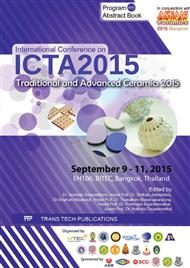p.71
p.76
p.81
p.87
p.92
p.97
p.103
p.109
p.114
Powder Injection Molding of Mullite: The Study of Mechanical and Physical Properties of the Sintered Products Using Statistical Methods
Abstract:
The aim of this work is to propose the application of statistical methods (linear regression and statistical hypothesis test) to analyze the effect of parameters used in powder injection molding including sintering temperature and the feedstock composition on the flexural strength, the porosity and the density of the sintered specimens of mullite prepared by powder injection molding (PIM) and using the composite binder consisting of 80 wt% polyethylene glycol (PEG) and 20 wt% polyvinyl butyral (PVB) for molding. The lab-scale plunger type PIM machine was used to prepare the specimens. The feedstock compositions were 50 to 54 vol% mullite, and the sintering temperatures were 1300 and 1400 °C. At level of significance 0.05 for statistical analysis, feedstock composition did not affect flexural strength, porosity, and density of the sintered specimens. For sintering temperature, the specimens sintered at 1400 °C have the greater density and the lower porosity. However, the flexural strength of the specimens sintered at 1300 °C and 1400 °C are statistically similar.
Info:
Periodical:
Pages:
92-96
Citation:
Online since:
May 2016
Price:
Сopyright:
© 2016 Trans Tech Publications Ltd. All Rights Reserved
Share:
Citation:


